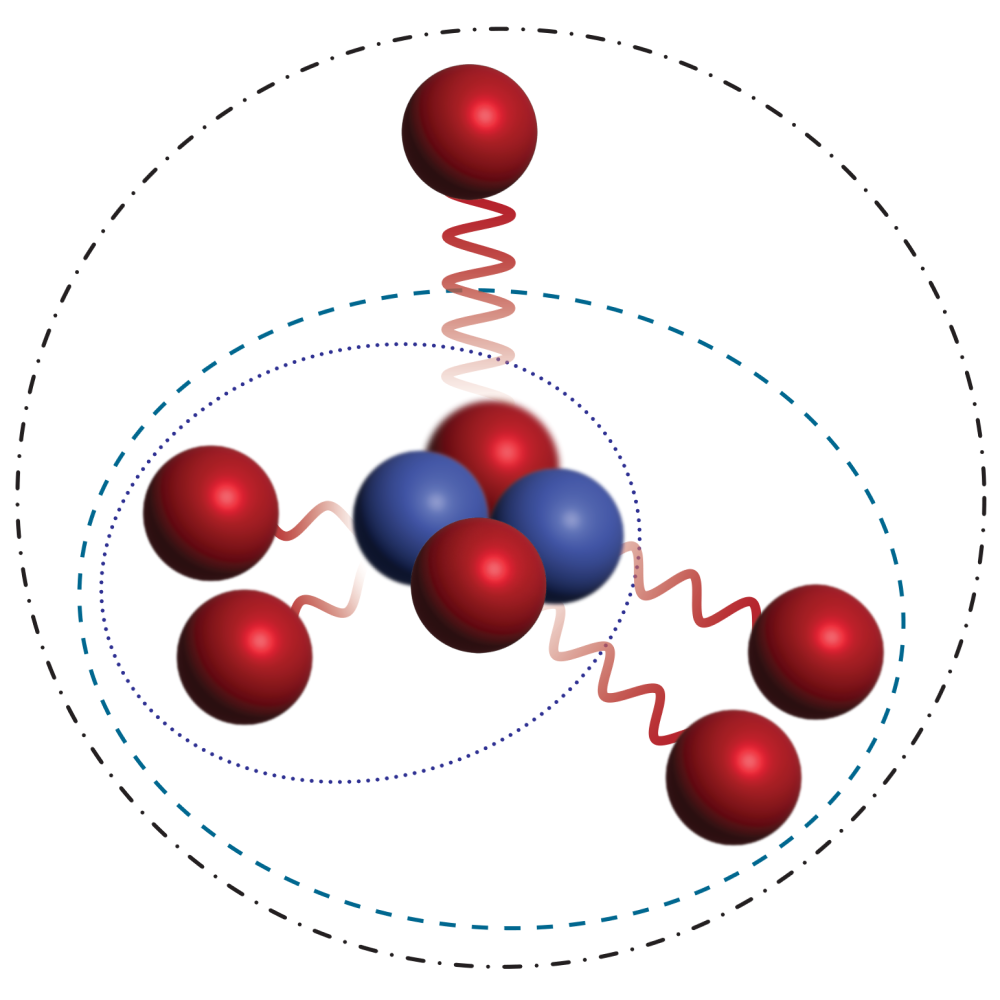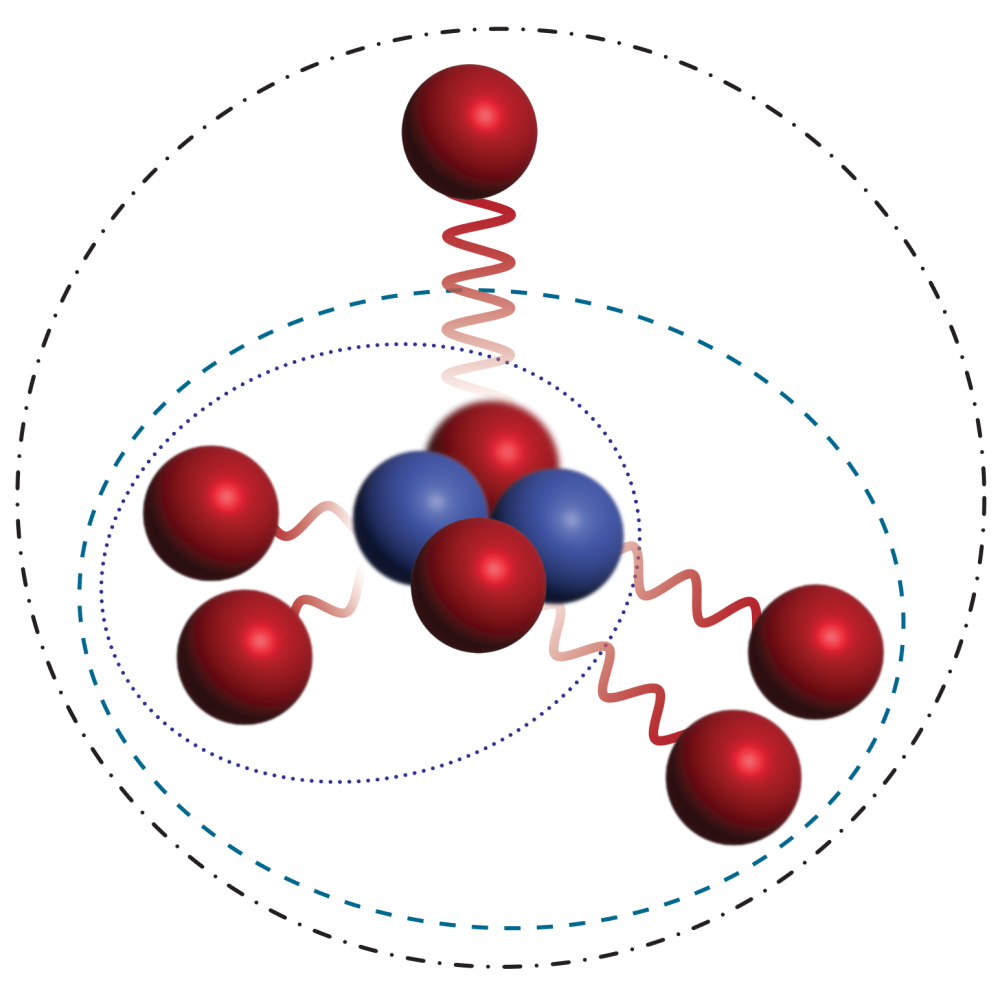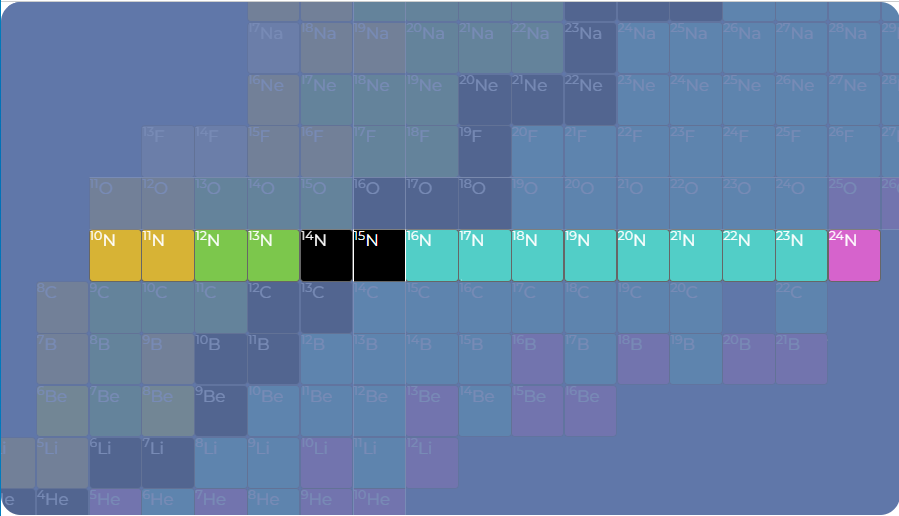Five Protons Spew Out of Extreme Nucleus
Researchers have found evidence of an extremely unstable nucleus for which more than half of the component particles are unbound, meaning that they are not tightly connected to the dense core of the nucleus [1]. The nucleus, nitrogen-9, is composed of a small helium-like core surrounded by five untethered protons that quickly escape after the nucleus’s formation. Previous experiments have seen at most four unbound protons in a nucleus. The research team had to carefully sift through a large volume of nuclear-collision data to identify the nitrogen-9 decays. This barely bound nucleus poses a unique challenge to theories of nuclear structure.
A nucleus with a large imbalance between its numbers of protons and neutrons is less stable than one in which the numbers are similar. In the extreme cases, these proton- or neutron-rich isotopes are unbound, meaning that one or more nucleons escape during decay. The boundaries between bound and unbound states—both on the proton-rich and on the neutron-rich sides of the nuclear landscape—are called drip lines. Researchers are interested in finding nuclei beyond the drip lines because they offer tests of models at the limits of nuclear existence. These exotic nuclei may also play a role in the formation of heavy elements in supernovae and in neutron star mergers.
Most beyond-drip-line nuclei decay by emitting one of their nucleons. For example, nitrogen-11 and nitrogen-10 both decay by emitting a single proton. But researchers have also measured nuclei that decay by emitting two, three, or four protons. While analyzing nuclear-collision data, Robert Charity from Washington University in Saint Louis and his colleagues stumbled on a signal that suggested a five-proton decay of nitrogen-9, a nucleus that is so far beyond the drip line that no one thought it would be detectable. “It’s such an exotic system that it wasn’t on anyone’s radar,” Charity says.
To confirm this detection, the team first modeled the nitrogen-9 structure. The core of the nucleus consists of two protons and two neutrons—resembling the helium nucleus. The five remaining protons are not bound to this core, but they still must tunnel through an energy barrier to escape, Charity explains. “It’s a very exotic nucleus, but it’s a nucleus,” he says.
The researchers calculated this tunneling behavior using a theory in which the nucleus emits protons in a way that resembles an atom emitting photons. Their calculations revealed a three-step process in nitrogen-9’s decay: First, one proton is emitted, leaving a carbon-8 nucleus behind. Then, two protons exit, producing beryllium-6. Finally, another two protons escape, so that only the helium core remains. This five-proton emission occurs in a matter of 10−21 seconds.
The team used the predictions to analyze the data more carefully. The experiments were performed in 2016 as part of a study of several proton-rich nuclei at the National Superconducting Cyclotron Laboratory (which was recently transformed into the Facility for Rare Isotope Beams). The researchers started with a beam of oxygen-16 nuclei and smashed it into a beryllium target. Out of the debris they isolated oxygen-13 nuclei, which they smashed into another beryllium target. Detectors recorded the outgoing particles from this second collision. For the nitrogen-9 study, the team selected events in which the collision products included one helium nucleus and five protons. After sifting out background events from other nuclear decays, the researchers found that these six-particle events produced a range of total energies, with the most likely value (the peak in the energy spectrum) matching the predicted nitrogen-9 mass [2].
There is some ambiguity about the detection because the peak in the energy spectrum may actually result from two unresolved peaks, possibly representing the ground state and an excited state of the nucleus. Charity says that he and his colleagues are considering follow-up experiments that would discriminate between one- and two-peak scenarios.
“When experimentalists reach new, more exotic nuclei, there is a chance to check whether our nuclear models are still adequate far from stability,” says nuclear physicist Marek Pfützner from the University of Warsaw in Poland. Nitrogen-9 provides an especially interesting check, he says, because a proton-rich nucleus has to contend with the repulsive electric force of the protons. “The fact that we can learn something about the two neutrons trying to keep seven protons together seems incredible to me.”
Nuclear theorist Marek Ploszajczak from the Large Heavy Ion National Accelerator (GANIL) in France is impressed that Charity and colleagues were able to find the signal of nitrogen-9 among all of the nuclear matter scattered from the collision site. He wonders if even more unbound nuclei await detection. “The challenging future question will not only be where is the drip line, but where is the limit of [nuclear] existence?” he says.
–Michael Schirber
Michael Schirber is a Corresponding Editor for Physics Magazine based in Lyon, France.
References
- R. J. Charity et al., “Strong evidence for 9N and the limits of existence of atomic nuclei,” Phys. Rev. Lett. 131, 172501 (2023).
- R. J. Charity and L. G. Sobotka, “Invariant-mass spectroscopy in projectile fragmentation reactions,” Phys. Rev. C 108, 044318 (2023).
More Information
More on the Facility for Rare Isotope Beams at Michigan State University: Research News: Rare Isotopes for the Choosing






